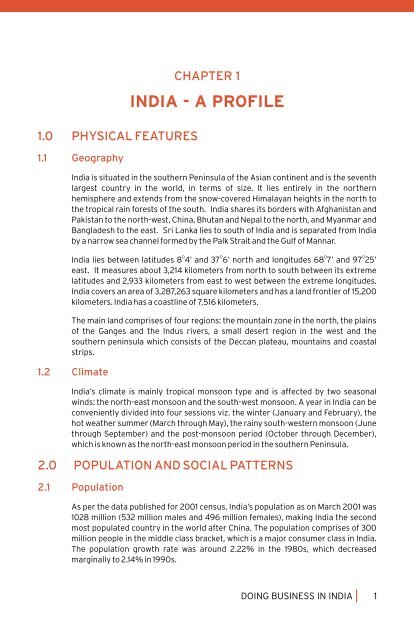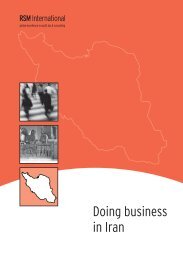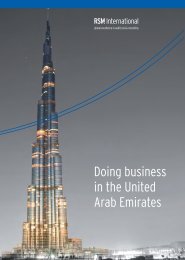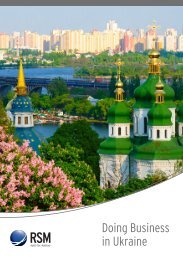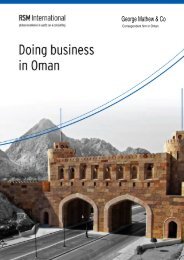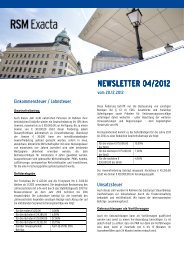Doing Business in India - RSM Austria
Doing Business in India - RSM Austria
Doing Business in India - RSM Austria
Create successful ePaper yourself
Turn your PDF publications into a flip-book with our unique Google optimized e-Paper software.
1.0 PHYSICAL FEATURES<br />
1.1 Geography<br />
CHAPTER 1<br />
INDIA - A PROFILE<br />
<strong>India</strong> is situated <strong>in</strong> the southern Pen<strong>in</strong>sula of the Asian cont<strong>in</strong>ent and is the seventh<br />
largest country <strong>in</strong> the world, <strong>in</strong> terms of size. It lies entirely <strong>in</strong> the northern<br />
hemisphere and extends from the snow-covered Himalayan heights <strong>in</strong> the north to<br />
the tropical ra<strong>in</strong> forests of the south. <strong>India</strong> shares its borders with Afghanistan and<br />
Pakistan to the north-west, Ch<strong>in</strong>a, Bhutan and Nepal to the north, and Myanmar and<br />
Bangladesh to the east. Sri Lanka lies to south of <strong>India</strong> and is separated from <strong>India</strong><br />
by a narrow sea channel formed by the Palk Strait and the Gulf of Mannar.<br />
0 0 0 0<br />
<strong>India</strong> lies between latitudes 8 4’ and 37 6’ north and longitudes 68 7’ and 97 25’<br />
east. It measures about 3,214 kilometers from north to south between its extreme<br />
latitudes and 2,933 kilometers from east to west between the extreme longitudes.<br />
<strong>India</strong> covers an area of 3,287,263 square kilometers and has a land frontier of 15,200<br />
kilometers. <strong>India</strong> has a coastl<strong>in</strong>e of 7,516 kilometers.<br />
The ma<strong>in</strong> land comprises of four regions: the mounta<strong>in</strong> zone <strong>in</strong> the north, the pla<strong>in</strong>s<br />
of the Ganges and the Indus rivers, a small desert region <strong>in</strong> the west and the<br />
southern pen<strong>in</strong>sula which consists of the Deccan plateau, mounta<strong>in</strong>s and coastal<br />
strips.<br />
1.2 Climate<br />
<strong>India</strong>’s climate is ma<strong>in</strong>ly tropical monsoon type and is affected by two seasonal<br />
w<strong>in</strong>ds: the north-east monsoon and the south-west monsoon. A year <strong>in</strong> <strong>India</strong> can be<br />
conveniently divided <strong>in</strong>to four sessions viz. the w<strong>in</strong>ter (January and February), the<br />
hot weather summer (March through May), the ra<strong>in</strong>y south-western monsoon (June<br />
through September) and the post-monsoon period (October through December),<br />
which is known as the north-east monsoon period <strong>in</strong> the southern Pen<strong>in</strong>sula.<br />
2.0 POPULATION AND SOCIAL PATTERNS<br />
2.1 Population<br />
As per the data published for 2001 census, <strong>India</strong>’s population as on March 2001 was<br />
1028 million (532 million males and 496 million females), mak<strong>in</strong>g <strong>India</strong> the second<br />
most populated country <strong>in</strong> the world after Ch<strong>in</strong>a. The population comprises of 300<br />
million people <strong>in</strong> the middle class bracket, which is a major consumer class <strong>in</strong> <strong>India</strong>.<br />
The population growth rate was around 2.22% <strong>in</strong> the 1980s, which decreased<br />
marg<strong>in</strong>ally to 2.14% <strong>in</strong> 1990s.<br />
DOING BUSINESS IN INDIA 1


